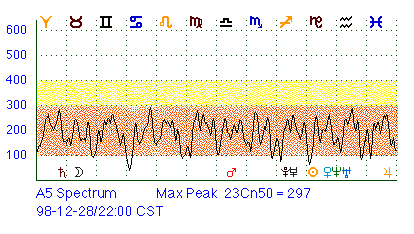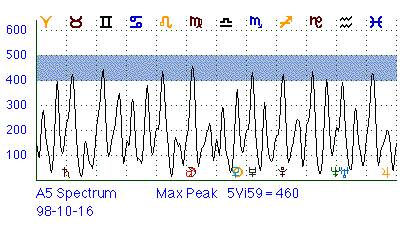
The idea of "strength" in the A5 Spectrum is quite straightforward. In terms of the graphs, it refers to the height of the tallest peak in a planetary waveform pattern. In experiential terms, it describes the intensity of the astrological influences present at a given time.
Wave phenomena appear in many areas of study, including mathematics, science and music. The strength or intensity of these waves are described by the distance between the peaks and the valleys in the wave. Larger distances indicate a more powerful phenomenon. The light is brighter, the sound waves are louder, the earthquakes topple more buildings, the stock market is more volatile, etc. In astrology, the effects of the planetary influences on our lives and behavior are more marked when the waves are bigger. The world feels more hurried, demanding, intense and out of control.
In order to produce one or more tall peaks in a waveform, a large number of planets must be focusing their influences on a single zodiacal position (via their aspects to this point). The strength of these tall peaks is measured by the numerical scale along the left side of these graphs, in terms of "units of aspect strength" or just plain "units". In particular, the height of the tallest peak is taken to be the strength of the entire waveform. The zodiacal position and height in units of this tallest peak are printed at the bottom of each graph.
The power or intensity of an astrological pattern is something that we feel or experience directly, within ourselves and in the world around us. The smaller, weaker patterns are generally quieter times that are easily weathered, although the lack of energy can often make it quite difficult to get anything done. It seems that without a "tailwind" of planetary support, it's hard to make any progress. The taller, more potent waveforms are generally extremely busy and demanding of our time, energy and attention. There's often more happening all at once than we can reasonably take care of. They can be quite productive times, since there's so much energy available to tap into, but only if you've settled on your plan of action beforehand and are reasonably skilled at "winging it" in the face of quickly changing demands. As in most matters, the moderate sized waveforms are usually the easiest to master. They have enough "oomph" to channel into your activities, but without being so overwhelming that you get swept away.
When designing the A5 Spectrum curves that represent the various aspects, I defined my strength units in terms of the conjunction aspect. Astrologers generally agree that the conjunction is the most potent of all the aspects, so I chose it as my standard.
The strength of an exact conjunction is defined to be exactly 100 units. It's worth keeping in mind the rule of thumb that "100 units is about 1 planet's worth of influence" when looking at a graph.
The other aspects have curves that range from 10 to 90 units in power, depending upon how they compare with the conjunction.
As the A5 Spectrum technique evolved over the years, our perverse imaginations often came up with silly terms to represent important intuitive notions. It makes life more fun. As the concept of "planetary storms" (prolonged periods of high energy influences) grew, so did the analogy to the weatherman's "alerts" and "warnings" when describing "stormy" influences. Since we somehow nicknamed these graphs "The Koz", terms like Koz Warning and Koz Alert grew like weeds.
Basically, the "Warning" region of the strength scale is between 400 and 500 units of strength. Any waveform whose tallest peak is between 400 and 500 units is therefore a Koz Warning. Similarly, any waveform with a tallest peak in the 500 to 600 unit region is a Koz Alert. The following graphs should make this clearer.

The wimpiest waveforms have such little energy that they're essentially astrological static or background noise. Such waveforms have a strength in the low 300's or less. The weakest waveform I've ever observed was only 288 units (I can't recall the date). It's nearly impossible to get much done during times like this, because the universe is unsupportive of your efforts.
Such weak energies often appear between planetary storms as one storm breaks up and another is just getting organized. These transition periods between storms are best used as a time of rest from activity -- see my "transition rules" for details.
For reasons that were never clear to us, these noisy graphs are also called "a mealy Koz" -- I think it has something to do with how the word "mealy" sounds to us.
I sometimes refer to the 100-300 unit area as "the noise region" of the graph. (The noise region of the preceding graph is shaded orange, while the yellow band is the 300 to 400 unit region.) Generally speaking, any peaks in this region are more "background noise" than significant astrological influences.

The Koz Warning region of 400 to 500 units (the shaded area) is one of moderately intense energy -- enough to do something with, not so much that we lose our bearings. Despite the ominous sounding name, Warnings are generally desirable and easy-going waveforms (depending upon the harmonics and the planets involved). Low Warnings (400-450) are usually a piece of cake; high Warnings (450-500) are a bit more challenging.

Koz Alerts are in the 500 to 600 unit range (the shaded region). Alert patterns always have a large number of planets working together to influence our lives, creating quite an overwhelming energy to deal with. Surfing one of these waves takes some skill, planning and practice. It's a good time to get some work done, since all this power and activity seems to easily overcome any inertia or obstacles that are holding you back. However, the action and chaos can sometimes overcome your best efforts, possibly making this a trying, stressful time. It helps to plan ahead for storm patterns like this, since there's precious little time to make plans when you're in the middle of the whirlwind.

If you thought Koz Alerts were a crazy time, you'll love a Koz Quake (600 units or above, the shaded region in the above graph). The roller coaster really jumps the tracks during one of these waveforms! They are fortunately rather rare (occurring only 1 to 3 times in a typical year) and make for a very memorable experience in hindsight. The strongest waveform I've observed so far was 686 units, on Apr 3, 1989 (shortly after the Exxon Valdez accident, when the extent of the environmental damage was becoming clear). The Grand Finale of Jan and Feb 97 was also a time of many powerful Quakes.